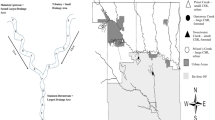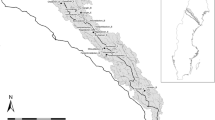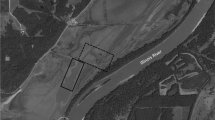Abstract
Tamarisk removal is a widespread restoration practice on rivers in the southwestern USA, but impacts of removal on fish habitat have rarely been investigated. We examined whether tamarisk removal, in combination with a large spring flood, had the potential to improve fish habitat on the San Rafael River in southeastern Utah. We quantified habitat complexity and the distribution of wood accumulation in a tamarisk removal site (treated) and a non-removal site (untreated) in 2010, 1 year prior to a large magnitude and long-duration spring flood. We used aerial imagery to analyze river changes in the treated and untreated sites. Areas of channel movement were significantly larger in the treated site compared to the untreated site, primarily because of geomorphic characteristics of the channel, including higher sinuosity and the presence of an ephemeral tributary. However, results suggest that tamarisk removal on the outside of meander bends, where it grows directly on the channel margins, can promote increased channel movement. Prior to the flood, wood accumulations were concentrated in sections of channel where tamarisk had been removed. Pools, riffles, and backwaters occurred more frequently within 30 m upstream and downstream of wood accumulations compared to areas within 30 m of random points. Pools associated with wood accumulations were also significantly larger and deeper than those associated with random points. These results suggest that the combination of tamarisk removal and wood input can increase the potential for channel movement during spring floods thereby diversifying river habitat and improving conditions for native fish.







Similar content being viewed by others
References
Abbe TB, Montgomery DR (1996) Large woody debris jams, channel hydraulics and habitat formation in large rivers. Regul Rivers Res Manag 12:201–221
Allred TM, Schmidt JC (1999) Channel narrowing by vertical accretion along the Green River near Green River, Utah. Geol Soc Am Bull 111:1757–1772
Angermeier PL, Karr JR (1984) Relationships between woody debris and fish habitat in a small warm-water stream. Trans Am Fish Soc 113:716–726
Balcombe SR, Bunn SE, McKenzie-Smith FJ, Davies PM (2005) Variability of fish diets between dry and flood periods in an arid zone floodplain river. J Fish Biol 67:1552–1567
Begin ZB (1981) Stream curvature and bank erosion: a model based on the momentum equation. J Geol 89:497–504
Begin ZB (1986) Curvature ratio and rate of river bend migration—update. J Hydraul Eng 112:904–908
Bezzerides NL, Bestgen KR (2002) Status review of roundtail chub (Gila robusta), flannelmouth sucker (Catostomus latipinnis), and bluehead sucker (Catostomus discobolus) in the Colorado River Basin. Larval Fish Laboratory Technical Report 118, Colorado State University
Birkeland GH (2002) Historical changes in flood power and riparian vegetation in lower Harris Wash, Escalante River Basin, Utah. Phys Geogr 23:59–78
Birken AS, Cooper DJ (2006) Processes of Tamarix invasion and floodplain development along the lower Green River, Utah. Ecol Appl 16:1103–1120
Bottcher JL (2009) Maintaining population persistence in the face of an extremely altered hydrograph: Implications for three sensitive fishes in a tributary of the Green River, Utah. Thesis, Utah State University
Bottcher JL, Walsworth TE, Thiede GP, Budy P, Speas DW (2013) Frequent usage of tributaries by the endangered fishes of the upper Colorado River Basin: observations from the San Rafael River, Utah. N Am J Fish Manag 33:585–594
Budy P, Bottcher J, Thiede GP (2009) Habitat needs, movement patterns, and vital rates of endemic Utah fishes in a tributary to the Green River, Utah. Annual Report to the U.S. Department of the Interior, Bureau of Reclamation. U.S. Geological Survey Utah Cooperative Fish and Wildlife Research Unit 2009 (4), pp 1–56
Buffington JM, Lisle TE, Woodsmith RD, Hilton S (2002) Controls on the size and occurrence of pools in coarse-grained forest rivers. River Res Appl 18:507–531
Bunn SE, Arthington AH (2002) Basic principles and ecological consequences of altered flow regimes for aquatic biodiversity. Environ Manag 30:492–507
Dauwalter DC, Sanderson JS, Williams JE, Sedell JR (2011) Identification and implementation of native fish conservation areas in the Upper Colorado River Basin. Fish 36:278–288
Davey AJH, Kelly DJ (2007) Fish community responses to drying disturbances in an intermittent stream: a landscape perspective. Freshw Biol 52:1719–1733
Deacon JE, Kobetich G, Williams JD, Contreras S (1979) Fishes of North America endangered, threatened, or of special concern: 1979. Fish 4:29–44
Dean DJ, Schmidt JC (2011) The role of feedback mechanisms in historic channel changes of the lower Rio Grande in the Big Bend region. Geomorphology 126:333–349
Dean DJ, Schmidt JC (2013) The geomorphic effectiveness of a large flood on the Rio Grande in the Big Bend region: insights on geomorphic controls and post-flood geomorphic response. Geomorphology. doi:10.1016/j.geomorph.2013.06.020
DeVries P, Fetherston KL, Vitale A, Madsen S (2012) Emulating riverine landscape controls of beaver in stream restoration. Fish 37:246–255
Di Tomaso JM (1998) Impact, biology, and ecology of saltcedar (Tamarix spp.) in the southwestern United States. Weed Technol 12:326–336
Duncan K (2003) Individual plant treatment of saltcedar. In: Hart CR (ed) Proceedings of the saltcedar and water resources in the west symposium, July 16–17, San Angelo, Texas, pp 106–110
Everitt BL (1998) Chronology of the spread of tamarisk in the central Rio Grande. Wetlands 18:658–668
Fagan WF, Unmack PJ, Burgess C, Minckley WL (2002) Rarity, fragmentation, and extinction risk in desert fishes. Ecology 83:3250–3256
Fausch KD, Northcote TG (1992) Large woody debris and salmonid habitat in a small coastal British Columbia stream. Can J Fish Aquat Sci 49:682–693
Follstad Shah JJ, Dahm CN, Gloss SP, Bernhardt ES (2007) River and riparian restoration in the southwest: results of the National River Restoration Science Synthesis project. Restor Ecol 15:550–562
Fortney ST (2014) Channel change on the lower San Rafael River, UT. Thesis, chapter 3, Utah State University
Fortney ST, Schmidt JC, Dean DJ (2011) Establishing the geomorphic context for wetland and riverine restoration of the San Rafael River. Natural Resource Conservation Service Cooperative Agreement #68-3A75-4-155, Intermountain Center for River Rehabilitation and Restoration, Logan, Utah
Friedman JM, Auble GT, Shafroth PB, Scott ML, Merigliano MF, Freehling MD, Griffin ER (2005a) Dominance of non-native riparian trees in western USA. Biol Invasions 7:747–751
Friedman JM, Vincent KR, Shafroth PB (2005b) Dating floodplain sediments using tree-ring response to burial. Earth Surf Process Landf 30:1077–1091
Glenn EP, Nagler PL (2005) Comparative ecophysiology of Tamarix ramosissima and native trees in western U.S. riparian zones. J Arid Environ 61:419–446
Graf WL (1978) Fluvial adjustments to the spread of tamarisk in the Colorado Plateau region. Geol Soc Am Bull 89:1491–1501
Griffin ER, Smith JD (2004) Floodplain stabilization by woody riparian vegetation during an extreme flood. In: Bennett SJ, Simon A (eds) Riparian vegetation and fluvial geomorphology: hydraulic, hydrologic, and geotechnical interaction: water science and application 8. American Geophysical Union, Washington, DC, pp 221–236
Harms RS, Hiebert RD (2006) Vegetation response following invasive tamarisk (Tamarix spp.) removal and implications for riparian restoration. Restor Ecol 14:461–472
Hart CR (ed) (2003) Proceedings of the saltcedar and water resources in the west symposium. 16–17 July, San Angelo, Texas
Hawkins CP, Kershner JL, Bisson P, Bryant M, Decker L, Gregory SV, McCullough DA, Overton K, Reeves G, Steedman R, Young M (1993) A hierarchical approach to classifying stream habitat features. Fish 18:3–12
Hultine KR, Belnap J, van Riper IIIC, Ehleringer JR, Dennison PE, Lee ME, Nagler PL, Snyder KA, Uselman SM, West JB (2010) Tamarisk biocontrol in the western United States: ecological and societal implications. Front Ecol Environ 8:467–474
Kennedy TA, Finlay JC, Hobbie SE (2005) Eradication of invasive Tamarix ramosissima along a desert stream increases native fish density. Ecol Appl 15:2072–2083
Labbe TR, Fausch KD (2000) Dynamics of intermittent stream habitat regulate persistence of a threatened fish at multiple scales. Ecol Appl 10:1774–1791
Laub BL, McDonough OT, Needelman BA, Palmer MA (2013) Comparison of designed channel restoration and riparian buffer restoration effects on riparian soils. Restor Ecol 21:695–703
Lisle TE (1981) Roughness elements: a key resource to improve anadromous fish habitat. In: Hassler TJ (ed) Proceedings: propagation, enhancement, and rehabilitation of anadromous salmonid populations and habitat in the Pacific Northwest. California Cooperative Fishery Research Unit, Humboldt State University
McAda CW, Berry CR Jr, Phillips CE (1980) Distribution of fishes in the San Rafael River system of the Upper Colorado River Basin. Southwest Nat 25:41–49
McDaniel KC, Taylor JP (2003) Saltcedar recovery after herbicide-burn and mechanical clearing practices. J Range Manag 56:439–445
Minckley WL, Deacon JE (1968) Southwestern fishes and the enigma of “endangered species”. Science 159:1424–1432
Naiman RJ, Bilby RE, Bisson PA (2000) Riparian ecology and management in the Pacific Coastal Rain Forest. BioScience 50:996–1011
Olden JD, Poff NL (2005) Long-term trends of native and non-native fish faunas in the American southwest. Anim Biodivers Conserv 28(1):75–89
Olden JD, Poff NL, Bestgen KR (2006) Life-history strategies predict fish invasions and extirpations in the Colorado River Basin. Ecol Monogr 76:25–40
Pitlick J, Van Steeter MM (1998) Geomorphology and endangered fish habitats of the upper Colorado River 2. Linking sediment transport to habitat maintenance. Water Resour Res 34:303–316
Pollen-Bankhead N, Simon A, Jaeger K, Wohl E (2009) Destabilization of stream banks by removal of invasive species in Canyon de Chelly National Monument. Arizona Geomorphol 103:363–374
Robinson CT, Tockner K, Ward JV (2002) The fauna of dynamic riverine landscapes. Freshw Biol 47:661–677
Shafroth PB, Cleverly JR, Dudley TL, Taylor JP, Van Riper C III, Weeks EP, Stuart JN (2005) Control of Tamarix in the western United States: implications for water salvage, wildlife use, and riparian restoration. Environ Manag 35:231–246
Stanford JA (1994) Instream flows to assist the recovery of endangered fishes of the Upper Colorado River Basin. Biological Report 24. National Biological Survey, U.S. Department of the Interior, Washington, DC
Taylor JP, McDaniel KC (1998) Restoration of saltcedar (Tamarix sp.)-infested floodplains on the Bosque del Apache National Wildlife Refuge. Weed Technol 12:345–352
United States Fish and Wildlife Service (USFWS) (2012) Endangered and threatened wildlife and plants; review of native species that are candidates for listing as endangered or threatened; annual notice of findings on resubmitted petitions; annual description of progress on listing actions. Fed Regist 77(225):69994–70060
Utah Division of Wildlife Resources (UDWR) (2006) Conservation and management plan for three fish species in Utah. Publication No. 06-17. Utah Department of Natural Resources, Division of Wildlife Resources, Salt Lake City, Utah
Van Steeter MM, Pitlick J (1998) Geomorphology and endangered fish habitats of the upper Colorado River 1. Historic changes in streamflow, sediment load, and channel morphology. Water Resour Res 34:287–302
Vincent KR, Friedman JM, Griffin ER (2009) Erosional consequence of saltcedar control. Environ Manag 44:218–227
Walsworth TE (2011) Analysis of food web effects of non-native fishes and evaluation of stream restoration potential for the San Rafael River, Utah. Thesis, Utah State University
Walsworth TE, Budy P, Thiede GP (2013) Longer food chains and crowded niche space: effects of multiple invaders on desert stream food web structure. Ecol Freshw Fish. doi:10.1111/eff.12038
Williams JD (1981) Threatened desert fishes and the Endangered Species Act. In: Naiman RJ, Soltz DL (eds) Fishes in North American deserts. Wiley, New York, pp 447–475
Williams JE, Bowman DB, Brooks JE, Echelle AA, Edwards RJ, Hendrickson DA, Landye JJ (1985) Endangered aquatic ecosystems in North American deserts with a list of vanishing fishes of the region. J Ariz-Nev Acad Sci 20:1–61
Acknowledgments
Funding for the restoration work was provided by the Wildlife Habitat Incentive Program (WHIP). Additional funding for projects and support was received through the Bureau of Reclamation Actions to Avoid Jeopardy program, the Bureau of Land Management, the Utah Watershed Restoration Initiative, the National Fish and Wildlife Foundation, the US Geological Survey, Utah Cooperative Fish and Wildlife Research Unit (in-kind), and the Natural Resource Conservation Service (NRCS) Technical Center, Portland, Oregon. Barry Hamilton, Wayne Greenhalgh, and Ammon Boswell from the NRCS were instrumental in providing funding and support for this work. We would like to thank Nathan Owens and Mike Ault of the Utah Division of Wildlife Resources for their efforts in the field, Justin Hart for his oversight and management of this project, and Gary Thiede and Phaedra Budy for help with figure preparation and for providing editorial comments. Thanks to Ian Gowing and Austin Jensen from Aggie Air™ for their collaboration and quick processing of the 2011 imagery that made this work possible.
Author information
Authors and Affiliations
Corresponding author
Rights and permissions
About this article
Cite this article
Keller, D.L., Laub, B.G., Birdsey, P. et al. Effects of Flooding and Tamarisk Removal on Habitat for Sensitive Fish Species in the San Rafael River, Utah: Implications for Fish Habitat Enhancement and Future Restoration Efforts. Environmental Management 54, 465–478 (2014). https://doi.org/10.1007/s00267-014-0318-7
Received:
Accepted:
Published:
Issue Date:
DOI: https://doi.org/10.1007/s00267-014-0318-7




